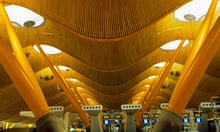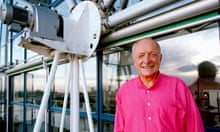One way to understand Richard Rogers is as a man who wanted everything. He wanted beautiful new buildings, a fair and civilised society and success for himself and his friends and collaborators. He was generous and tough, romantic and political. He wanted to be in the middle of it all. Such wishes made for a lifetime of majestic achievement, an impact as great as any British architect has ever made.
Two documents from his early life sum him up. When he was born, his cousin Ernesto Rogers, a fine Milanese architect, wrote him a letter: don’t eavesdrop behind the door of life, it advised, break through it. As a student at the Architectural Association in London, R got a damning report from one of his teachers. His drawing was bad, it said, his method of work chaotic, his critical judgment inarticulate.
He did indeed break the door open. The AA report was also largely true. His genius was to overcome his weaknesses with charm, charisma and determination, and to ally himself with other brilliant people who could do what he couldn’t. His early architectural career was in the partnership of Team 4, with Norman Foster, Foster’s wife, Wendy Cheeseman, and Rogers’s wife, Su, all of whom had skills that he lacked. He designed the Pompidou Centre in Paris with Renzo Piano and an array of other talents.
With his second wife, Ruth, Rogers created a social universe around the River Café restaurant, which started as a canteen for his practice, and the triple-height living space of the home they made by knocking two Chelsea townhouses together. An enduring image of Rogers is of him in a cerise or lime-green shirt, standing on the house’s elegant steel staircase, with Andy Warhol prints of Chairman Mao on the walls, making a gracious if slightly incoherent speech to a party that might include a Hollywood star, a cultured footballer or a world-famous artist.
With his omnivorous desire went an obliviousness to contradiction, complexity and the obstinacy of facts. This can be seen in an early house that he and Su designed for the photographer Humphrey Spender; enthralled by the steel-and-glass “case study” houses of California, Rogers wanted to achieve the same in rural Essex, without much allowance for differences in climate. In his first winter in the house, Spender sent Rogers a wry Christmas card, a photograph of the frost patterns that formed on the inside of the single-glazed walls.

The same obliviousness could be seen in Rogers’s work with Tony Blair, John Prescott and Ken Livingstone to revitalise British cities with the help of good design. This achieved a true transformation of political and cultural attitudes to urban life, but it also entailed accommodations with property interests at odds with the inclusive principles he championed. There could be conflicts of interest between Rogers the social campaigner and Rogers the leader of an ambitious practice: “good design” too often turned out to mean the high-tech style that he and his allies offered. At worst, the results would be something like One Hyde Park in Knightsbridge, a block of super-luxury flats with fortress-like security systems that gives nothing very much to the public realm around it.
He could be ruthless in getting his way. Often, his projects didn’t work out as advertised or came at considerable cost to his clients. He successfully wielded the power of British libel laws against the American author Stewart Brand, whose book How Buildings Learn had, in its US edition, challenged the claims of Rogers’s designs to be flexible and adaptable. In the UK version, as if in a Soviet retouched photograph, these sections were replaced by something altogether else.
My relationship with Rogers was often spiky. I criticised projects such as his plan to envelop London’s Southbank arts centre with a giant glass roof, with perhaps excessive iconoclastic rage. To which he didn’t take kindly. And yet news of his death, at the age of 88, hit me hard. His courage was phenomenal. And he was, in the end, one of the good guys. The Pompidou Centre, half a century after its inception, remains a blast of joy, energy and invention in the heart of a historic city. Even clients he nearly bankrupted, even Spender with his freezing house, were won over by the power of his vision.
“Naivety is an important part of creativity,” Rogers told his partner, Graham Stirk. In the case of this particular architectural giant, you couldn’t get one without the other.








